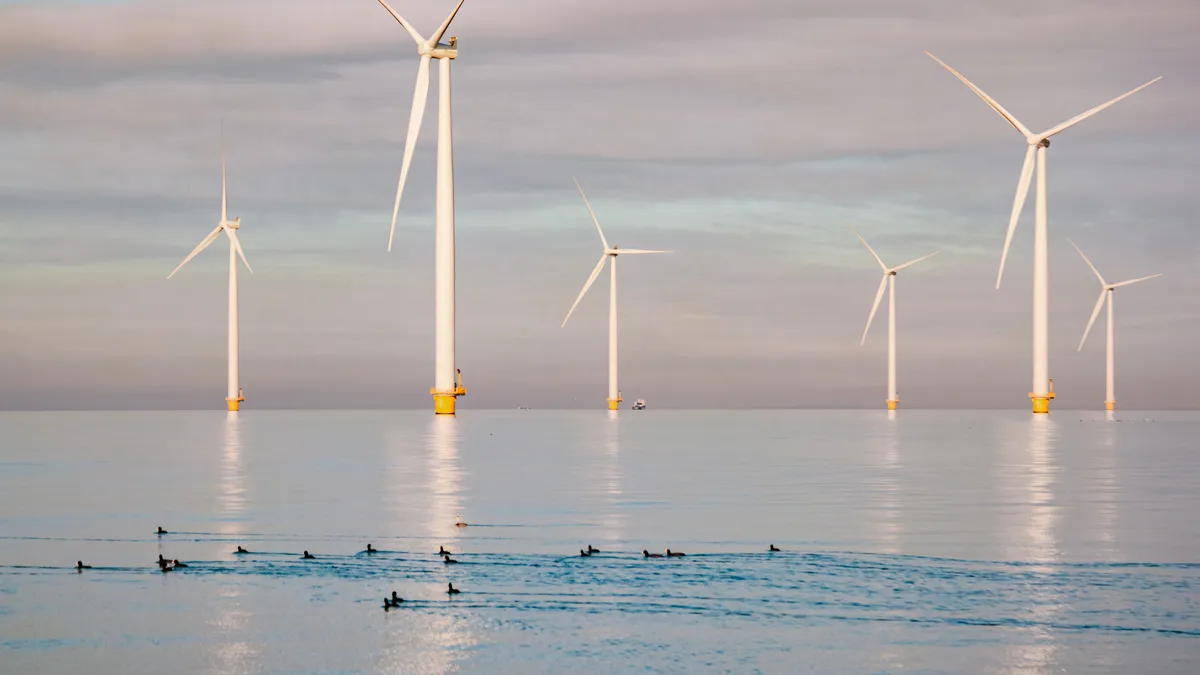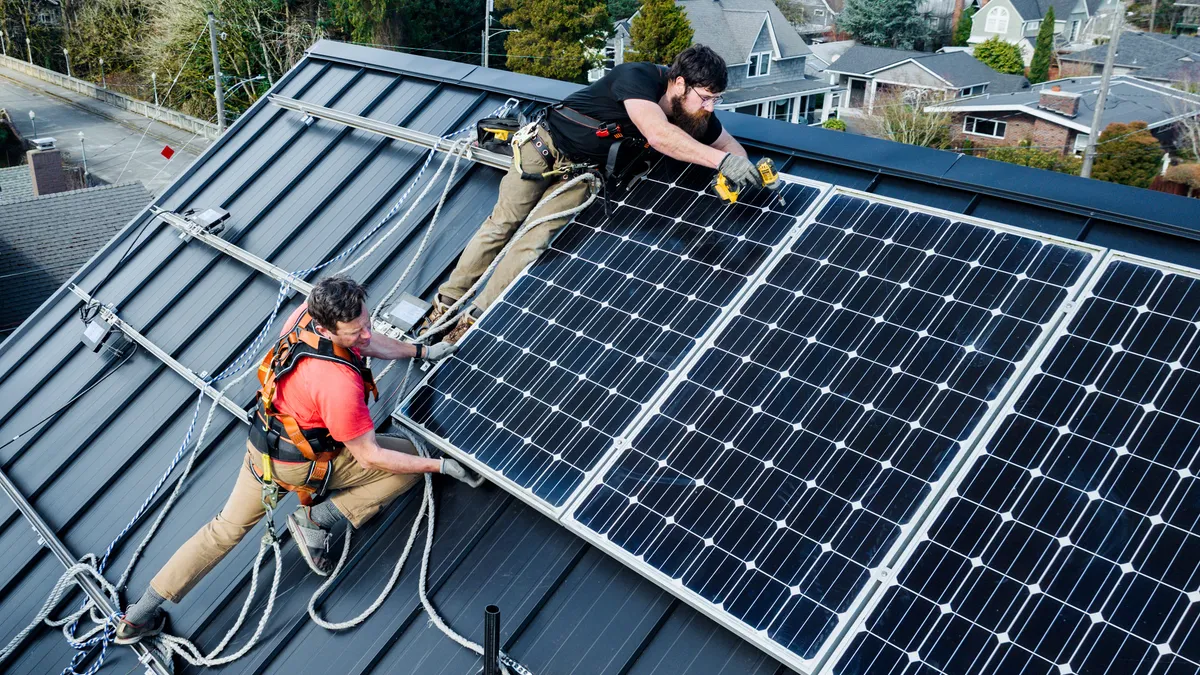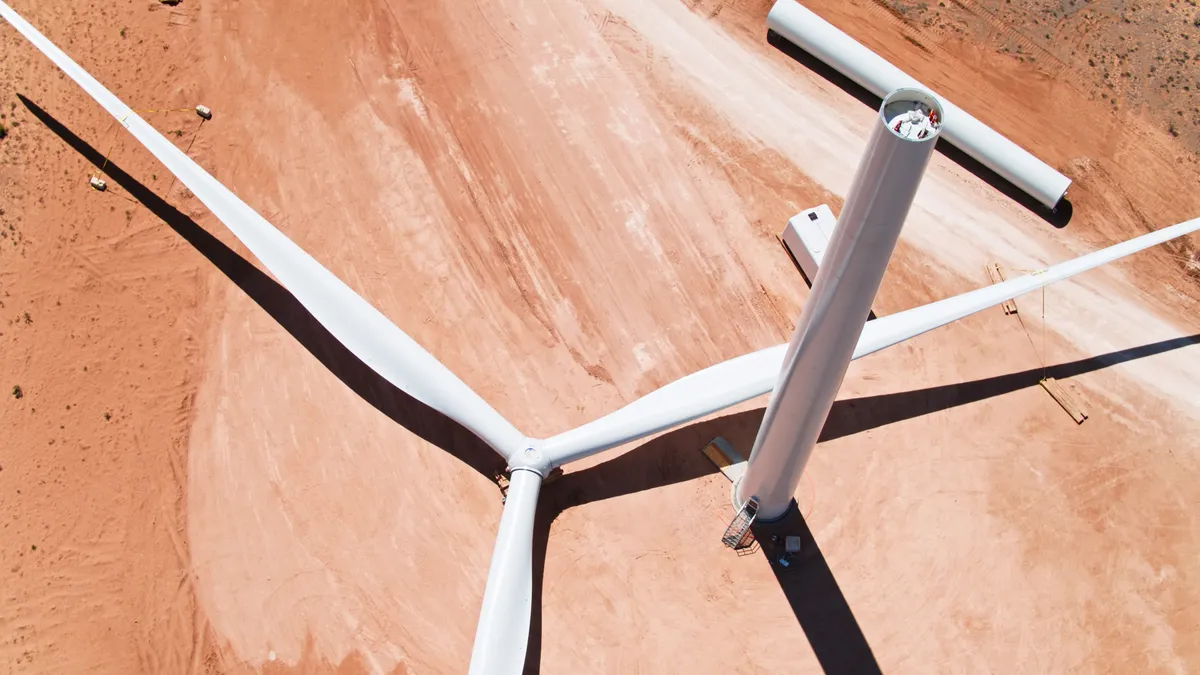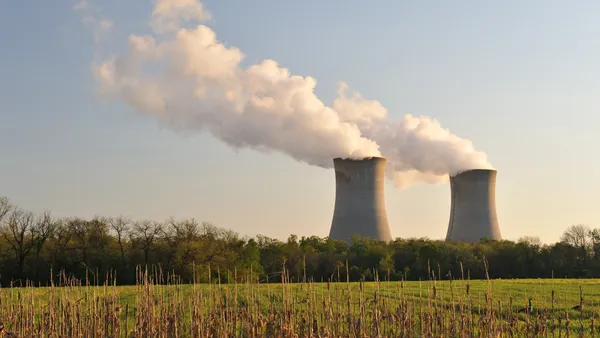Because elections have consequences, almost everybody in the power sector now foresees unwanted uncertainty.
“Donald Trump’s win has put the environment clearly at risk,” New Jersey Sierra Club Director Jeff Tittel said, echoing concerns of the wider environmental community. “Forty years of environmental progress could be rolled back, putting the health of our people and even the entire planet at risk.”
But people in the wind and solar industries, which were transformed during the Obama administration from afterthought alternatives to mainstream energy resources, remain optimistic.
“Our industry will be fine,” Sunnova CEO John Berger told Utility Dive. Sunnova is one of the leading national rooftop solar providers. “Business models will change and the companies that can’t deliver a better service at a better price won’t make it.”
Losing its 30% federal investment tax credit (ITC) might even provoke constructive change, Berger said. “But with or without the ITC, this industry will thrive and that is because we are quickly driving down the cost of solar and solar components and now the cost of batteries is coming down as fast.”
Wind energy is on track to continue “thriving” for reasons that have little to do with policy or politics, said Wendy Davidson, director of wind energybusiness development at Mortenson Construction. Mortenson is one of the wind industry’s leading providers of engineering, procurement, and contracting (EPC) services.
Although wind's leaders will be attentive to policy developments in the Trump administration, Davidson said, “the industry is committed to capitalizing on today’s opportunities and we have numerous customers planning to build 1,000 MW or more in the next four years.”
Wind industry optimism is, however, based on the existing tax policy, Davidson acknowledged. And Mortenson, along with the rest of the people who work in wind and solar and the rest of the nation, is waiting to “see how things unfold” in the Trump presidency.
The president-elect’s energy sector promises
President-elect Trump’s “100-Day Action Plan to Make America Great Again” lists seven actions aimed at protecting American workers. Three address the energy sector.
The first is lifting restrictions on “job-producing American energy reserves, including shale, oil, natural gas and clean coal.”
Another is lifting roadblocks to “vital energy infrastructure projects, like the Keystone Pipeline.”
The third is cancelling funding commitments to U.N. climate change programs and using the money “to fix America’s water and environmental infrastructure.”
For the third action, the president-elect would ask Congress to pass a revenue neutral law leveraging public-private partnerships and private investments “through tax incentives, to spur $1 trillion in infrastructure investment over ten years.”
Finally, the plan promises “an energy revolution” through “full use of our domestic energy sources, including traditional and renewable energy sources” that will make the country “a net energy exporter.”
The Trump administration will use the nation’s “trillions of dollars” in coal, oil, and natural gas resources to create “millions of new jobs” and protect "clean air, clean water, and natural habitats," according to the plan.
The undermining of domestic fossil fuel producers under the Obama administration will end, the President-elect promises. Onshore and offshore leasing of federal lands and waters will be increased, permitting for all energy projects will be streamlined, and the coal mining lease moratorium will be rescinded, signaling the end of the Obama administration's "war on coal.”
The Obama administration’s Climate Action Plan, Clean Power Plan, and other “restrictions” on domestic energy will also be lifted, resulting in “more jobs, more revenues, more wealth, higher wages, and lower energy prices.”
The Trump administration environmental policies “will be guided by true specialists in conservation, not those with radical political agendas,” the plan concludes.
It is not clear how Mr. Trump will protect clean air and water with so much emphasis on support for “traditional sources of energy,” said Andy Beck, director of public affairs at the Department of Energy during the second Bush administration.
“It will also be interesting to see how he balances the increased use of natural gas with his focus on bringing back coal,” said Beck, now the energy vice president at corporate consultant Makovsky.
The first concrete indication of Mr. Trump’s energy policies may come with his choice of who will head the Department of Energy (DOE).
Pro-nuclear Trump loyalist Sen. Jeff Sessions (R-AL) reportedly wants Donald Hoffman, President/CEO of Excel Services, a nuclear energy builder, to head the DOE.
Harold Hamm, CEO of the billion-dollar natural gas giant Continental Resources and a leading advocate for the fracking method of exploration and development, is also thought to be high on Mr. Trump’s list.
Mike Mckenna, president of energy industry consultant MWR Strategies, lobbyist for Dow Chemical, Southern Company, and Koch Industries, and head of the Trump DOE transition team, is one of two political professionals in the running.
The other is venture capitalist Robert Grady, who directed the George H.W. Bush administration Office of Management and Budget’s Natural Resources, Energy, and Science team and worked on the Clean Air Act of 1990.
Tax reform first — will it include renewables?
“President-elect Trump has indicated that tax reform is a priority,” according to Sr. Counsel Curt Beaulieu of Bracewell, the firm that supplied the lawyers to argue against the Clean Power Plan and used to employ Rudy Giuliani.
“Look for the tax reform debate to be placed front and center in the new Congress,” Beaulieu said.
The long term extensions and phase outs of the solar ITC and the wind industry’s $0.023/kWh production tax credit (PTC) "could be part of the discussion,” Beck said.
The ITC and PTC that were agreed to at the end of 2015 and run through the early 2020s “are factored into the long-term growth of the solar and wind industries,” former Colorado Public Utilities Commission Chair Ron Binz, now president of Public Policy Consulting, told Utility Dive.
A change to that 2015 agreement is one of the few ways the Trump administration could interrupt the growth of wind and solar, he added.
It would be difficult to build congressional momentum for attacking that agreement because it has bipartisan support from districts across the country where solar and wind have driven job growth, Binz said. “But if they move forward with a big tax policy revision, everything would be on the table.”
Bloomberg Intelligence Analyst Cheryl Wilson thinks the ITC and PTC tax credits are “probably safe.” The Trump administration’s “short-term impact on renewables may be limited,” she emailed Utility Dive.
Those perspectives back up news from last week, when a Trump transition team insider told Utility Dive that renewable energy was not on Trump’s hit list. But Trump’s campaign and first transition days have proven more erratic than any of his modern predecessors, so there’s a chance any policy commitment could change.
If that happens, and Trump and Congressional Republicans attempt to go after the tax incentives or other renewable energy supports, they could use a budget reconciliation procedure to get around a Democratic filibuster. Using that, Republicans could push through a budget with only 51 votes
It is too early to know if that will happen or if the ITC and PTC would be part of such an effort. The Trump administration could, however, interfere with the wind and solar tax credits without going through Congress by using either of two other options.
“If Trump and the Republican-led Congress prioritize tax reform, it may threaten the value of the credits for project owners,” Bloomberg’s Wilson pointed out.
Binz explained this. “If the Trump administration cuts the corporate tax rate to 15%, it would dilute the effect the PTC and ITC,” he said. “The tax credits become less valuable as corporate tax rates fall because there would be less taxes to offset.”
A second option would be White House instructions to the internal revenue service (IRS) to revisit the guidance on qualifying for crucial provisions in the tax credits. Both the PTC and ITC contain “commence construction” provisions that extend their availability into the early 2020s.
“With the current PTC rulings,” Mortenson’s Davidson said, “projects that demonstrate, according to IRS guidance, that construction commenced in 2016 have until the end of 2020 to go online to get 100% of the PTC benefit.”
Those that qualify in 2017 have until the end of 2021 to get 80% of the benefit, those that qualify in 2018 have until end of 2022 to get a 60% benefit, and those that qualify in 2019 have until the end of 2023 to get 40% of the tax credit, she added.
Utility-scale solar installations that demonstrate adequate construction before 2020 could have 30% of the investment returned at the end of their first year of operation if they go into service within two years. If construction begins in 2020, they would get a 26% tax credit. If construction begins in 2021, the tax credit is for 22% of the investment. If construction begins after 2021, the tax credit is 10% if they go online by 2024.
To avoid a public political battle against wind and solar, the Trump administration could have the IRS do the work, former Bush official Beck said. “He could have the IRS revise its interpretation of the “commence construction” provision so that the tax credits sunset sooner.”
Bloomberg’s Wilson expects the current administration to try to head off that option.
“Before President Obama leaves office, the Treasury Department may issue important guidance,” she said. A firm backing of the commence construction provision's current interpretation “could further insulate the sector from uncertain future policy priorities under Trump.”
The Trump administration, however, retains the option of having the IRS revisit its guidance, Beck believes.
The strengths of wind and solar
The wind and solar industries have always touted their effects on U.S. job growth, but in the aftermath of last Tuesday, those aspects of the sector were given new significance.
In his election night congratulations to Trump, Solar Energy Industries Association (SEIA) Interim President Tom Kimbis added the reminder the solar “is creating thousands of jobs and billions of dollars in investments across American communities.”
At the same time, American Wind Energy Association CEO Tom Kiernan added that “wind power supports 88,000 well-paying American jobs, a quarter of them made-in-the-USA manufacturing jobs.”
Over 80% of all wind farms are in Republican-held congressional districts, Kiernan reminded the incoming administration. “We envision that the Republican leadership in Congress and the White House will want to keep our industry growing.”
Wind is already price-competitive in many parts of the country, Davidson added. “And the cost continues to go down. The industry’s commitment is to evolving its technology and delivering wind generation at the lowest possible cost regardless of policy.”
Both solar and wind have market strength, Binz agreed. “Wind is now below $25/MWh in the Midwest and the West and solar is under $45/MWh or lower in some places in the Southwest and the South and most forecasts agree improving technologies will continue to drive those prices down,” he said. “That is an independent driver that nobody in Washington is going to upset.”
Sunnova CEO Berger was more adamant. “It is fundamentally not true that the solar and wind industries need the support of the federal government,” he said.
“If the government were to step away and the renewables industries showed how their massive improvements in costs and technology have made them market competitive, it would completely change investors’ perceptions and drive a tidal wave of investment,” he said.
The wind and solar industries “have arrived” and “are going to move forward no matter who is in the White House,” Berger said. “If we can get the federal government out of the U.S. power sector and allow customers to have more choice, the future is even brighter.”
Over three-fourths (76%) of the Mortenson survey respondents saw power purchase agreements with corporate and industrial off-takers as adding to future wind growth, Davidson said. Drivers include corporate commitments to sustainability and the environment (44%), wind’s value as a hedge against energy price rises (32%), and wind's price competitiveness (24%).
George Hershman, general manager at Swinerton Renewable Energy, which will act as EPC in 2016 for over a gigawatt of utility-scale solar, is also optimistic.
“The president-elect has said solar is expensive and it will take an educational process to help him see his information is outdated,” Hershman said.
“Once he sees that solar prices have fallen so low it is competing on price and that it is creating thousands of blue collar jobs, he will see it the same way he sees the other energy sectors,” he added.
SEIA is working with the Trump transition team and Republicans in the Senate and House on that educational process, Hershman said. “It is the same process that won Congressional support for the ITC extension.”
Solutions ahead
The costs for wind and solar dropped so far and so fast during the Obama administration that those industries will “continue to see strong growth well into the future,” Beck said. “I wouldn’t be surprised if Mr. Trump pursues an “all-of-the-above” energy strategy similar to President Bush’s, with less restrictions on traditional resources but with adequate support for alternative resources as well.”
Binz is urging utility executives to remember the cost effectiveness of renewables and to “continue making smart choices now that pay off for their companies in the long run,” he said. “Getting as much solar and wind into their resource mixes while these tax policies are in place is a strategy that is independent of almost any politics.”
He is also working on a way to “show utilities how to get out of old unproductive assets and up-cycle their capital investment by securitizing and buying down stranded assets and reinvesting the capital in more productive assets, including wind and solar,” Binz added.
Renewables advocates will surely “fight like hell to keep the hard-won ITC and PTC compromise of 2015 in place,” Binz said. But if they are turned back by administration strategies, they should consider real estate investment trusts (REITs) and master limited partnerships (MLPs).
REITs and MLPs are available to the oil and gas and utility industries, but because of tax law technicalities, are not readily available to wind and solar, he said. “If the tax credits come under attack, they could be part of a negotiation.”
Berger sees wind and solar bringing consumer choice to the U.S. power industry under the Trump administration. “The only regulation we need is to give consumers choice. Other than that, get out of the way and let our businesses compete,” he said.
“I am going to make sure President Trump and everybody else knows that wind and solar will grow the economy and create jobs,” Berger added. “This industry is now so fundamentally sound that whatever goes on in the Trump administration, we will continue to grow. We got it from here."






















